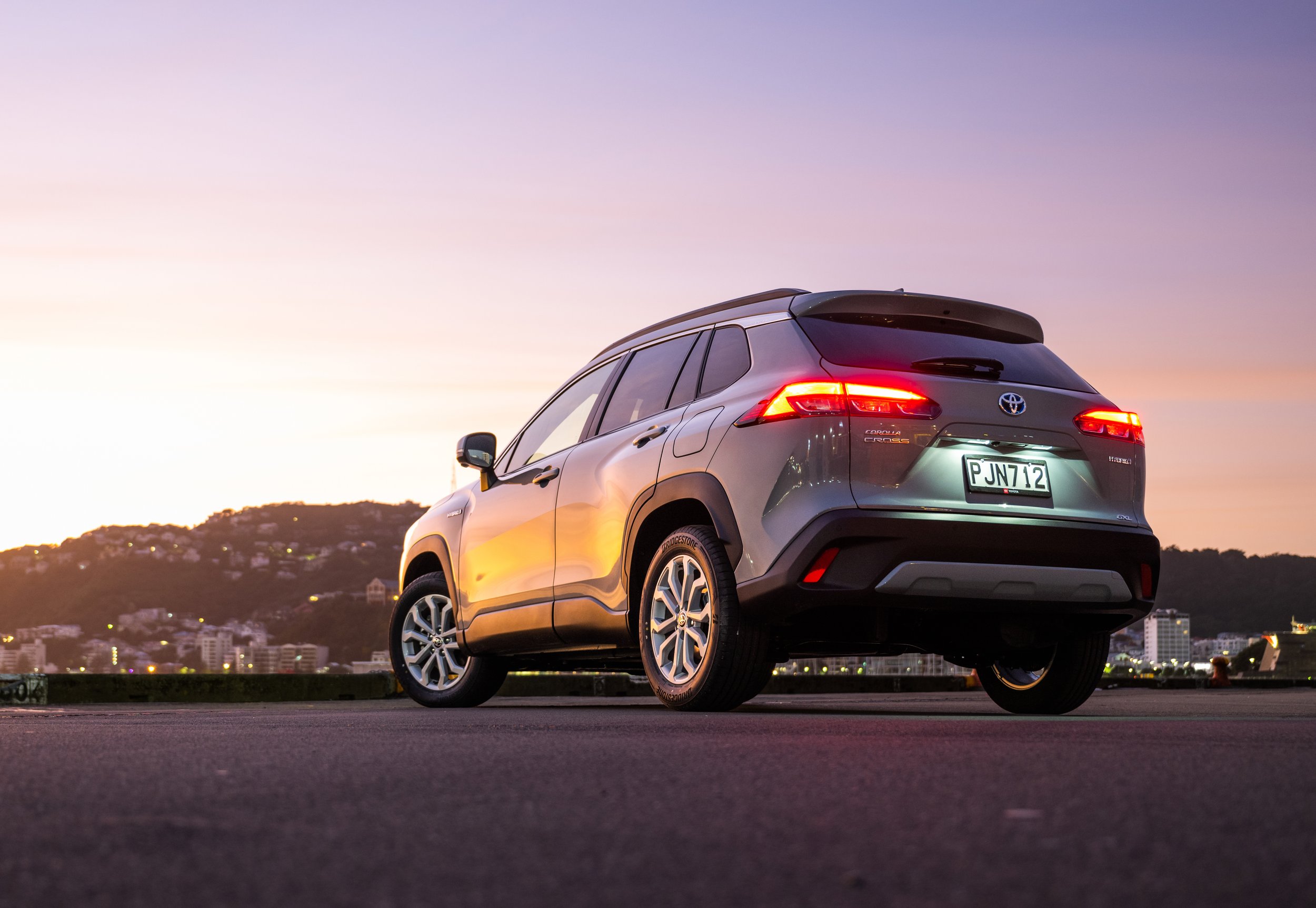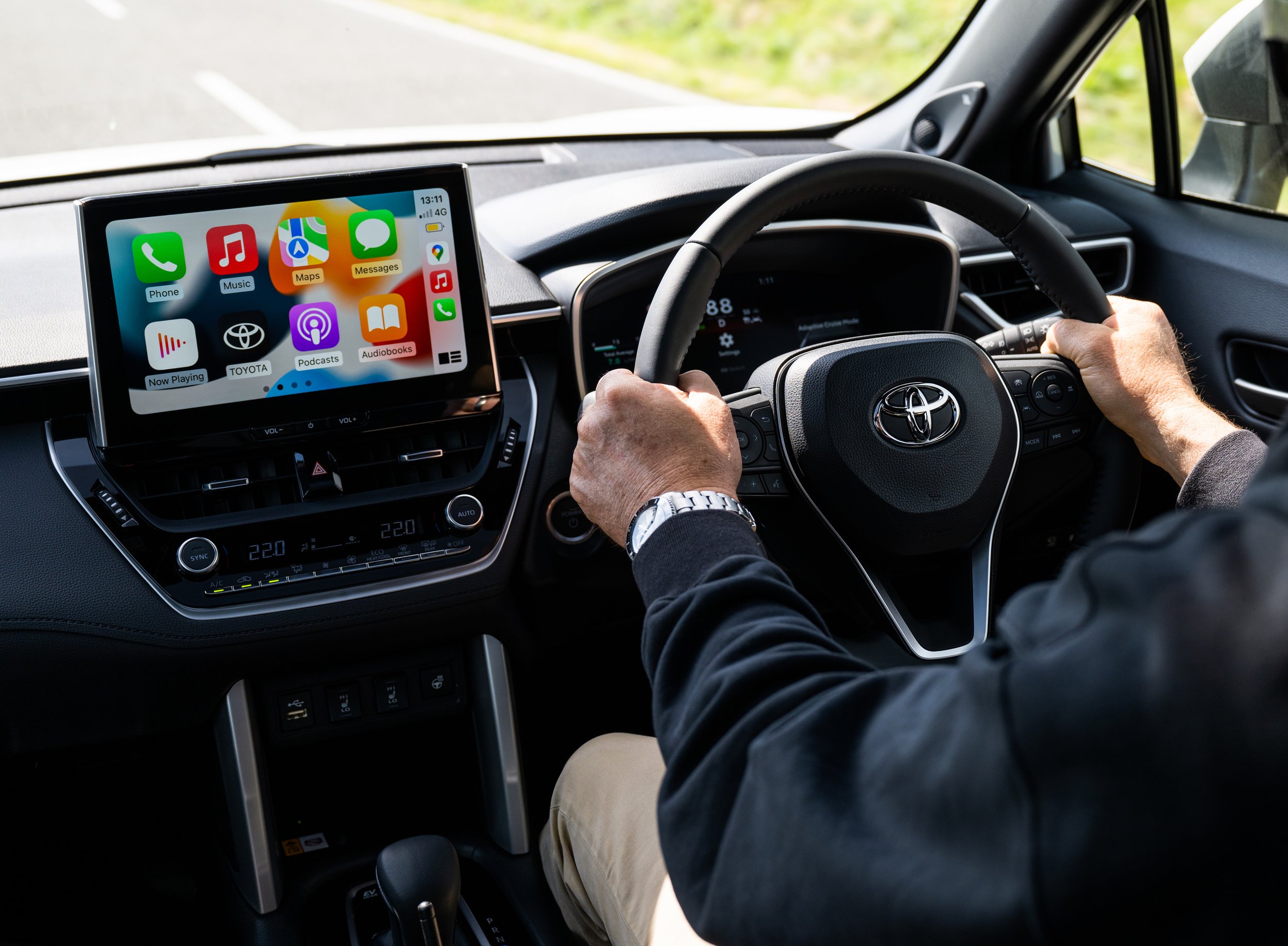Toyota Corolla Cross first drive review: New job for old faithful
/Dressed for outdoorsy undertaking, more realistically tailored for urban adventuring … a thematic we’ve surely now become well-used to is one Toyota plays to full advantage here.
PONDERING exactly what specific role is set to be played by this new model designed to fill a gap between the Yaris Cross and the big-selling RAV4, and also conceivably offer as a more practical alternate to the C-HR, also due replacement next year?
My advice would be to consider the bigger picture; but perhaps not too seriously the one Toyota NZ showed at the media conference, in which all the models mentioned already were grouped with the Highlander, Fortuner, Land Cruiser Prado and Land Cruiser 300. A nice family portrait, the brand reckons. But how closely related are they really?
On strength of its styling and, to a degree, the overall size, you could just about conceive the newbie standing up to the RAV4. From a first drive experience, I’d say it’d be best not to get your hopes up. RAV4 in its own right is not exactly a small-scale Land Cruiser, but it does deliver a modest but real amount of extra off-road ability and ruggedness which, I’d suggest, is beyond what rolls out here.
While TNZ says it’s a sports utility, the naming convention surely pops that balloon. ‘Cross’ just has to be short-hand for crossover, the kind of car that by definition has a SUV look but none of the ability.
Here just the flagship bothers with all-wheel-drive, and even then it’s a $3000 option on the Limited which also represents, at $48,990, with the front-drive that is sole choice in the entry $41,990 GX and mid-family $44,990 GXL.
None are all that elevated, not even the all-paw has any additional drivetrain assists and there’s just a hint of extra protection on the wheelarches and under the nose and tail.
Considering it mainly as a larger-sized hatchback is hardly an impediment. There are many others like it, after all. Just being dressed for the part will help it win interest and having a high hip point seating position, likewise.
There’s another ‘H’ factor playing handily. Hybrid is obviously entirely intrinsic to the local pitch to stay sweet with Government’s rigid decarbonisation ideals and to achieve a market-leading CO2 average among brands that have electric, electrified and fossil fuel-pure models. Outside of the sports cars, you won’t find a Toyota passenger choice without it.
These days Kiwis like petrol-electric to point of making it a preference. TNZ finds “is it hybrid?” is the first question asked about any new model. If it is, the deal is so much easier done.
Corolla Cross picks up the fifth generation tech but the basics introduced to our world 28 years ago by the Prius (another name about to disappear from here) remain constant. Still, Corolla Cross reminds how Toyota is forever tidying up the details, through improving efficiency, making the hardware more compact and engineering the operability to make the switch between engine and electric motor and energy-recuperation ever more seamless.
Comprising a 2.0-litre four-cylinder and electric involvement, this 135kW/190Nm powertrain is a new derivative that has a lithium ion battery that is 14 percent lighter but offers a 14 percent greater power output over the version previously found in Corolla hybrid hatchback.
In use, it does the usual stalwart, if emotionally-uninvolved, job. You have options for getting the engine and recuperative braking to recharge the battery at a keener rate, or you can leave it to its own devices, and it always keeps at least a little charge in the battery for some silent running, mainly only drawing electric on start-off, then kicking into petrol from 30kmh, if not earlier. Toyota says the new battery translates into slightly more prolonged periods of engine-off running, but the emphasis is likely on ‘slightly’. On the introductory day it never seemed to be running on pure battery for anything but short periods. It is quick, however, to disengage the engine when you lift off the accelerator.
When engine and electric combine, it has decent pull and is smooth in its transitions between petrol, electric and dual-power running. So long as you don’t rush things. The one CVT irk no maker has yet to quell is how poorly they can respond to any attempts to make haste. This one is no improvement. Flooring the throttle is a fast track to inducing it into high-pitched flap. Best to just stick with a light right foot and not even bother with the ‘sport’ mode.
Keep those expectations suitably orientated and it not only drives well but seems well placed to entertain the impressive economy cited by the brand. Even on 91 octane petrol, Toyota believes it’ll give 4.8L/100km in front-drive format, rising to 4.9L/100km for AWD. CO2 emissions of 107g/km and 112g/km are also good enough for Clean Car rebates, of $3108 and $2851. If you’re out to talk up its Green side, mention also should go to the bumper being in three parts now, not just to make repair cheaper also recycling easier, and that it lacks an engine cover because that’s deemed an unnecessary use of plastic (plus it’s a weright-saving).
Otherwise, it’s business as usual. It’s an easy car to handle and the suspension smooths out most surfaces, though damping calibration varies between model types. Some of this might come down to tyre choice; the low and mid spec cars are on 215/60 R17s whereas the Limiteds uplift to wider 225/50 18-inch rubber. The broader compounds not only make the car feel more secure but, surprisingly, seem quieter on most surfaces, too. Still, overall on first impression it’s a car that generally feels nicely balanced and co-ordinated.
You’d say the same about the shape. Looks-wise, it’s hard to pick any particular familial association with other Corollas other than the badging. No panels seem shared; I’d be surprised if even the wing mirrors shared. The silhouette is solid and friendly, if not particularly special in any way. Another example of Toyota stylists’ playing it safe? Being a global car for Toyota, it has to appeal to a broad audience. On the other hand, the same could be said of the smaller C-HR and Yaris Cross, which have more striking designs.
Save for perhaps one aspect; the headlamp design. Toyota has a ‘thing’ for its cars now having dramatic-looking and sized lamps, but these are something else. While the housing is quite narrow, it is deceptively long; something you only fully appreciate when viewing the car in profile or opening the bonnet. The measuring tape reveals the element is 82 centimetres’ long. The only Toyota with a more elongated housing, by a mere 4cms, appears to be a pukka SUV, the much larger Highlander.
Impression this is a car designed with practicality and lifestyle usage in mind carries into an interior in which one talking point is this line delivering NZ-market introduction to Toyota’s latest-generation infotainment system, which supports wireless Apple CarPlay and wired Android Auto and also comes, in ultimate form, with a induction recharging pad for your cellphone.
GX has an eight-inch touchscreen but those above get a 10.5-inch screen, with integrated sat-nav, which is hardly missed on the base car as it’ll run your phone’s mapping.
The new system seems faster than the old, but the big improvement is in the graphics and screen quality; everything’s so much sharper and renderings are truly modern. The screen is at an ideal height and, just as sensibly, physical controls are retained for everyday functions such as adjusting the climate control.
Other Corollas will get this with a mid-life facelift presumably coming soon (it’s already hit other markets) and so too does the facelifted Highlander, also impending.
The cabin architecture is otherwise familiar Corolla. Trim levels run from pure cloth at base level, with increasing integration of faux leather as spend increases. The driving position is solid and front headroom decent, but though it beats CH-R on rear seat room it’s still tight; the tall will find that diminishing roofline robs headroom. Corolla hatch’s biggest obvious burden is poor boot space. Corolla Cross, with 436 litres expanding to 1359 litres when the rear seats are folded, isn’t the biggest, either, but still beats the other five-door hands down.
One element of difference is that the whole boot is deeper, to point where there is a drop down to the boot floor from the loading lip. It carries a space saver spare.
The design is different enough for the car to demand crash testing, with Toyota locally confident it will achieve the same five star ANCAP accreditation as other Corollas.
All Corollas gain Toyota Safety Sense, a tech bundle that loads in a pre-collision warning system, adaptive (radar-controlled) cruise control, lane trace assist to help the driver remain in the correct lane, automatic high-beam lights and traffic sign recognition.
The models beyond the base spec also achieve parking sensors at both ends and automatic rear-cross traffic braking.
The type provides a good level of equipment for the asking price without going overboard. Buy anything but a GX and you get a leather steering wheel, but Limited is the best go-to for comfort features. It has powered and heated front seats, a nine-speaker JBL audio system and a powered tailgate.
The Cross is taking Corolla into new territory and arrives when the sedan format that kicked off the nameplate in 1966 and has accounted for a huge chunk of the 44 million worldwide sales over 12 generations is bowing out due to lack of interest.
Where next for Corolla? In the short term, it’s with the super racy GR that lands next year and will be the only one in the family that ignores requirement for a battery-involved powertrain.
Whether Corolla Cross one day commits more to electric is worth thinking about, if only because it’s one the same platform used by the Lexus UX, which now includes a wholly electric offer.
Toyota, of course, has made well clear it intends to march to the beat of a different drum. It says even though it is targeting 3.5 million global sales of electric vehicles annually by 2030, there’s still plenty of space in its portfolio for combustion involvement. Still, it’s a pity they haven’t offered a plug-in hybrid system.
From first acquaintance, the Cross seems another well-rounded package with every potential of accounting for a fair chunk of Corolla sales going forward (perhaps even eroding the hatchback’s share). Not least if it raises interest from rental companies, which historically has been the line’s biggest fan club and are now restocking their fleets, with Toyota NZ eager to help that process.





















